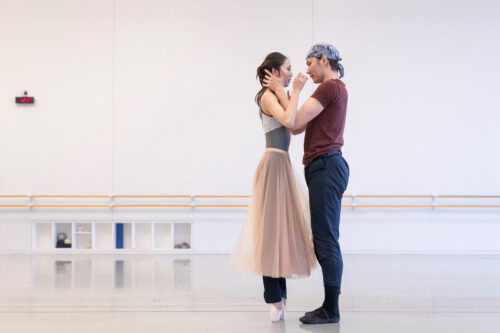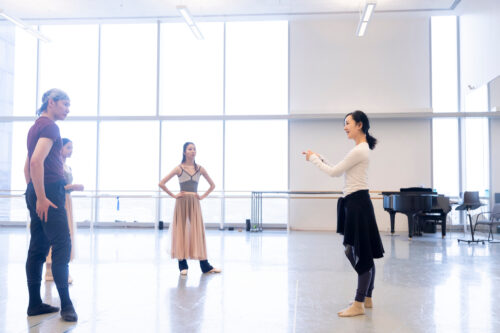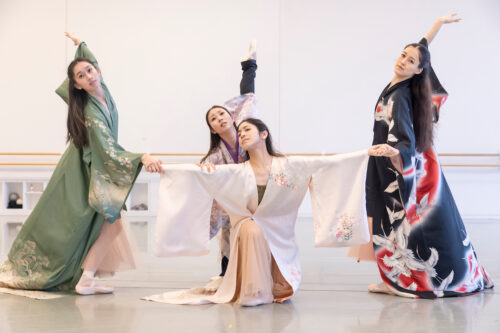Nao Kusuzaki Helms World Premiere of Genji

Speaking with the eloquent and worldly Nao Kusuzaki about her new ballet, Genji, it occurred to me that I had experienced this quiet, yet, charged presence before. As our conversation progressed, I remembered that I had written about Kusuzaki’s performance in Stanton Welch’s Madame Butterfly more than a decade ago.
As a young dance writer, Nao’s performance made a vivid impression on me. “[Butterfly] is a woman who is ruled by the world around her, but is always in control of her destiny. Kusuzaki plays her with reckless abandon, and the audience feels every emotional strain.” Now a creator in her own right, I was eager to hear about her process in tackling the eleventh-century text, The Tale of Genji, considered by many to be the world’s first novel.
One of her creative impulses as a choreographer is her love of heritage and culture. She organized a benefit concert to raise funds for the relief efforts after the 2011 earthquake in Japan, and it was then that she saw the far-reaching impact of the production side of dance. “That was a big moment for me, realizing how dance could contribute to a bigger cause,” says Kusuzaki. “The artistic elements brought comfort and peace and togetherness in the community.”
After working on a commission from Asia Society Texas in 2015, she founded Creative Minds Collaborative in 2016 with the aim to “cultivate cultural understanding between Houston’s diverse communities and their artists.”

In her latest partnership with Asia Society Texas, Kusuzaki again pays homage to her Japanese culture by reworking the ancient Genji text into a contemporary framework. One cannot overstate the challenge of such a task. The best story ballets, such as the Stanton Welch creation that Kusuzaki starred in, require a simplicity of narrative that allows the dancing to do the heavy lifting. The Tale of Genji is anything but that, and is largely preoccupied with the social and political intrigue of the Heian period upper classes.
To distill the narrative for a theatrical presentation, Kusuzaki chose specific valences to work from. “The important thing to me was to show the cultural elements of the story,” she says. “These would be the Japanese traditions and the arts that flourished 1,000 years ago.”
And rather than maneuvering the political dynamics of the time period, Kusuzaki also made the decision to focus on the motivations of the characters. “I decided to focus on the relationships,” she says. “Especially the female voices, which are often untold in these older stories.”
To bring the context of the story to life, including the poetry, instrumentation, and dance forms that are referenced in the novel, Kusuzaki worked with composer and musician Kaoru Watanabe. This was the first time she had worked with commission music, but together they devised a plan for tackling the structure of the ballet.
“In the beginning, [Watanabe] wanted to see the scenes broken down and written out,” says Kusuzaki. “For example, who is dancing in what scene and what is happening, so we created a short version of the ballet in words.” From there, Watanabe started crafting the composition by designating a specific instrument to each character. The flute will be used to illustrate the lead character of the Emperor’s son, Hikaru Genji.
The partnership between choreographer and composer proved to be a fortuitous one. Kusuzaki had danced to Watanabe’s music prior to the commission and was a fan of his work. But his care in evoking the traditional Japan of the novel was in line with Kusuzaki’s reimagining. “He uses traditional instruments to create a contemporary soundscape,” she says.

Costume and set design also work to enhance the choreography, which is dominated by solo work and pas de deux between the Prince and the four women in his life. “You can see the Emperor’s wife through her fabric, the many layers of kimono, and a longer train,” says Kusuzaki. “The set design [by Ryan McGettigan] is minimal, and features a huge version of a traditional screen to show the division of male and female, and the separation of social classes.”
In speaking with Nao, it is clear to me that Genji is a very personal endeavor. It is an expression of her love of Japanese culture and her desire for her audiences to experience the beauty that she considers innate. She also wants the story ballet format to be a tool for creating communion in a disparate world.
“Through this tale, through the screen, you will see people divided,” she says. “We’re not absolutely sure why we feel we won’t be able to understand them, but there is a mutual understanding. And I feel like my purpose is to bring people together through dance and have that sense of community.”
I’m excited to accept Nao’s invitation to look through the screen to find a world less divided.
Asia Society Texas, in partnership with Houston Ballet, presents Nao Kusuzaki’s Genji on March 24 & 25 at 7:30pm. Tickets are available now at asiasociety.org.



Recent Comments